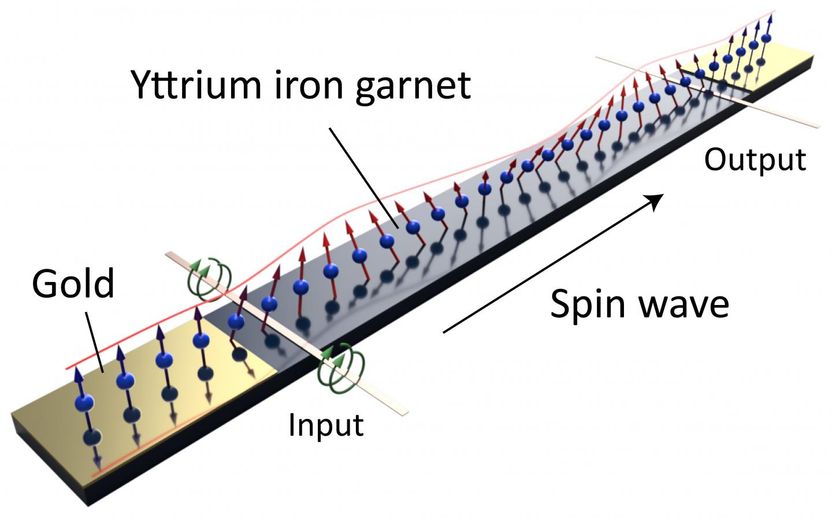Smooth propagation of spin waves using gold
Assistant Professor Taichi Goto at Toyohashi University of Technology elucidated the noise generation mechanism of the spin wave (SW), the wave of a magnetic moment transmitted through magnetic oxide, and established a way to suppress it. The large noise generated by SWs traveling through magnetic oxides has presented a significant obstacle to its applications. However, it became clear that noise can be suppressed by installing a thin gold film in the appropriate places. This method is expected to be applied to SW devices such as multi-input and multi-output phase interference devices for SWs.

This is a magnetic oxide film treated with gold film capable of suppressing SW noise.
COPYRIGHT (C) TOYOHASHI UNIVERSITY OF TECHNOLOGY. ALL RIGHTS RESERVED.
Recent electronic devices using semiconductor materials are having difficulty meeting the demand of a rapidly growing information society due to issues such as a high chip temperature due to high integration. Development of an SW logic circuit that can process information, and significantly suppress heat generation through transmitting only SWs without transferring electrons themselves, has been attracting attention. SWs that propagate through magnetic oxides have the advantage of low energy loss and a long transmission distance. On the other hand, as the loss is so small, SW reflected at the end of the material or interface with the electrode disturb the target spin wave. This phenomenon is called SW noise, which has made SW unsuitable for application in the past.
The Spin Electronics Group of Toyohashi University of Technology discovered that forming a gold film with sufficient length at the end of an yttrium iron garnet (YIG), which is a well-known magnetic oxide material, suppresses the generation of unnecessary SWs. In addition, the group found for the first time that SW noise is also sensitive to the position of the gold film.
"There are series of new devices using SWs and findings of new phenomena, yet there hasn't been much research on finding out how to transmit SWs through magnetic oxide or elucidating the cause of the generation of disturbing SWs.", said Assistant Professor Goto.
The first author master course student Shimada who ran the simulation said, "We analyzed the fundamental propagation characteristics of the structure using gold film. Since this method can significantly suppress the noise, it will contribute to the development of SW devices that use magnetic oxide. Furthermore, SW logic circuits that use phase information can be realized as the phases of waves are stabilized." SW propagation characteristics were calculated and analyzed based on the finite element analysis method, by computer generating a three-dimensional model that has the same size as the sample used in the actual experiment. A model with a pair of electrodes for exciting SWs and a gold film for removing noise placed on the magnetic oxide was used to find out how gold film affects SW propagation by comprehensively changing the length of magnetic oxide materials, the position of the gold film, and the distance from the electrode. The result showed that when the distance between the gold film and the electrodes is long, a standing wave of SWs is generated, causing strong noise. The group learned that the noise can be suppressed by positioning the gold film close enough to the electrodes. This helps smoothen the propagation characteristics, and realizes a stable element design that can keep the influence of some frequency variations and disturbances to the entire device, to the propagation characteristics, small.
This simulation is a known method with high reproducibility. Therefore, the method is expected to be applied to SW devices such as multi-input/multi-output phase interference devices for SW in the future.
Original publication
Most read news
Original publication
Kei Shimada, Taichi Goto, Naoki Kanazawa, Hiroyuki Takagi, Yuichi Nakamura, Hironaga Uchida and Mitsuteru Inoue; "Extremely flat transmission band of forward volume spin wave using gold and yttrium iron garnet"; Journal of Physics D: Applied Physics; 2017
Topics
Organizations
Other news from the department science

Get the chemical industry in your inbox
By submitting this form you agree that LUMITOS AG will send you the newsletter(s) selected above by email. Your data will not be passed on to third parties. Your data will be stored and processed in accordance with our data protection regulations. LUMITOS may contact you by email for the purpose of advertising or market and opinion surveys. You can revoke your consent at any time without giving reasons to LUMITOS AG, Ernst-Augustin-Str. 2, 12489 Berlin, Germany or by e-mail at revoke@lumitos.com with effect for the future. In addition, each email contains a link to unsubscribe from the corresponding newsletter.



























































